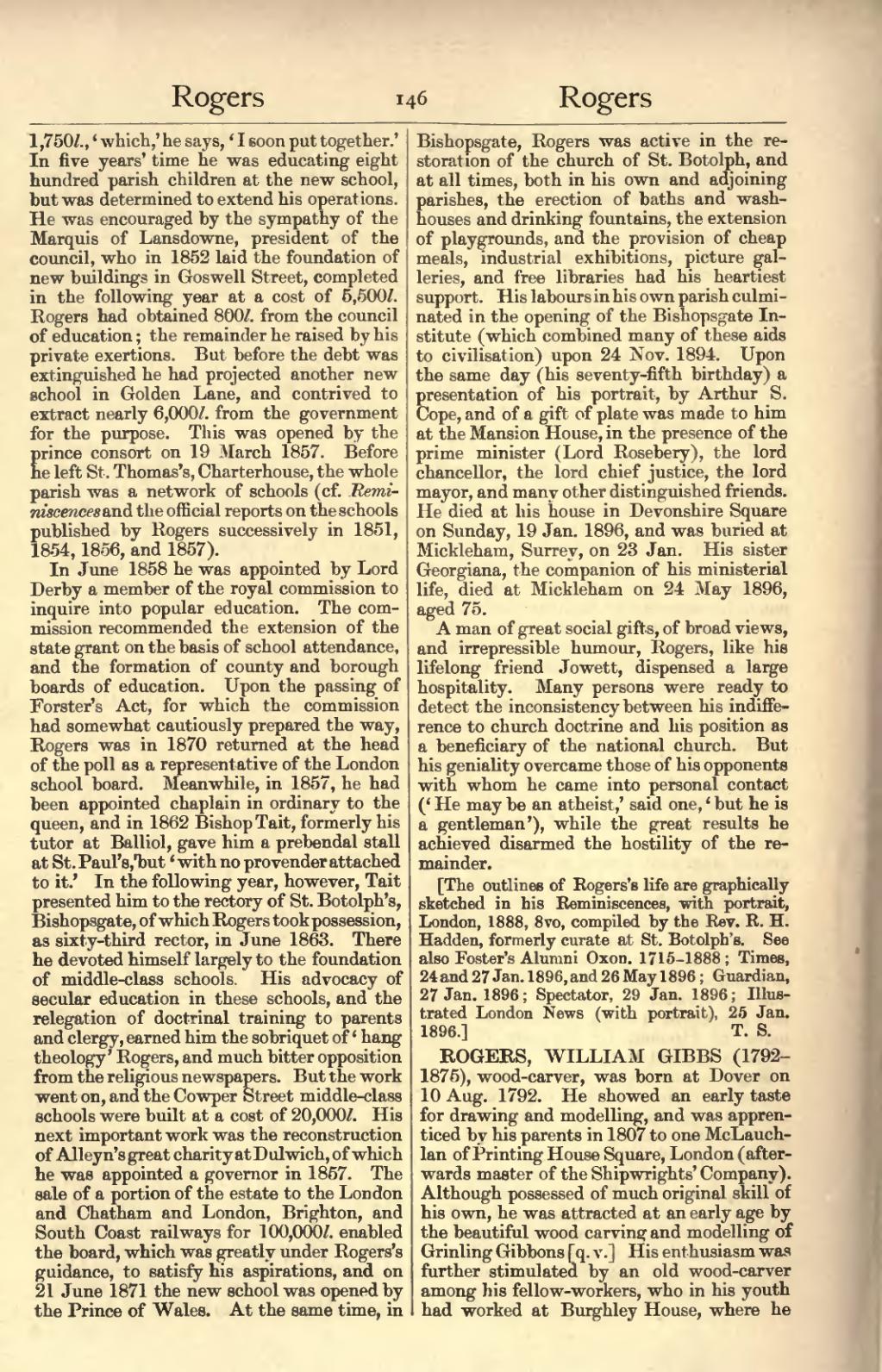of 5,500l. Rogers had obtained 800l. from the council of education; the remainder he raised by his private exertions. But before the debt was extinguished he had projected another new school in Golden Lane, and contrived to extract nearly 6,000l. from the government for the purpose. This was opened by the prince consort on 19 March 1857. Before he left St. Thomas's, Charterhouse, the whole parish was a network of schools (cf. Reminiscences and the official reports on the schools published by Rogers successively in 1851, 1854, 1856, and 1857).
In June 1858 he was appointed by Lord Derby a member of the royal commission to inquire into popular education. The commission recommended the extension of the state grant on the basis of school attendance, and the formation of county and borough boards of education. Upon the passing of Forster's Act, for which the commission had somewhat cautiously prepared the way, Rogers was in 1870 returned at the head of the poll as a representative of the London school board. Meanwhile, in 1857, he had been appointed chaplain in ordinary to the queen, and in 1862 Bishop Tait, formerly his tutor at Balliol, gave him a prebendal stall at St. Paul's, but ‘with no provender attached to it.’ In the following year, however, Tait presented him to the rectory of St. Botolph's, Bishopsgate, of which Rogers took possession, as sixty-third rector, in June 1863. There he devoted himself largely to the foundation of middle-class schools. His advocacy of secular education in these schools, and the relegation of doctrinal training to parents and clergy, earned him the sobriquet of ‘hang theology’ Rogers, and much bitter opposition from the religious newspapers. But the work went on, and the Cowper Street middle-class schools were built at a cost of 20,000l. His next important work was the reconstruction of Alleyn's great charity at Dulwich, of which he was appointed a governor in 1857. The sale of a portion of the estate to the London and Chatham and London, Brighton, and South Coast railways for 100,000l. enabled the board, which was greatly under Rogers's guidance, to satisfy his aspirations, and on 21 June 1871 the new school was opened by the Prince of Wales. At the same time, in Bishopsgate, Rogers was active in the restoration of the church of St. Botolph, and at all times, both in his own and adjoining parishes, the erection of baths and wash-houses and drinking fountains, the extension of playgrounds, and the provision of cheap meals, industrial exhibitions, picture galleries, and free libraries had his heartiest support. His labours in his own parish culminated in the opening of the Bishopsgate Institute (which combined many of these aids to civilisation) upon 24 Nov. 1894. Upon the same day (his seventy-fifth birthday) a presentation of his portrait, by Arthur S. Cope, and of a gift of plate was made to him at the Mansion House, in the presence of the prime minister (Lord Rosebery), the lord chancellor, the lord chief justice, the lord mayor, and many other distinguished friends. He died at his house in Devonshire Square on Sunday, 19 Jan. 1896, and was buried at Mickleham, Surrey, on 23 Jan. His sister Georgiana, the companion of his ministerial life, died at Mickleham on 24 May 1896, aged 75.
A man of great social gifts, of broad views, and irrepressible humour, Rogers, like his lifelong friend Jowett, dispensed a large hospitality. Many persons were ready to detect the inconsistency between his indifference to church doctrine and his position as a beneficiary of the national church. But his geniality overcame those of his opponents with whom he came into personal contact (‘He may be an atheist,’ said one, ‘but he is a gentleman’), while the great results he achieved disarmed the hostility of the remainder.
[The outlines of Rogers's life are graphically sketched in his Reminiscences, with portrait, London, 1888, 8vo, compiled by the Rev. R. H. Hadden, formerly curate at St. Botolph's. See also Foster's Alumni Oxon. 1715–1888; Times, 24 and 27 Jan. 1896, and 26 May 1896; Guardian, 27 Jan. 1896; Spectator, 29 Jan. 1896; Illustrated London News (with portrait), 25 Jan. 1896.]
ROGERS, WILLIAM GIBBS (1792–1875), wood-carver, was born at Dover on 10 Aug. 1792. He showed an early taste for drawing and modelling, and was apprenticed by his parents in 1807 to one McLauchlan of Printing House Square, London (afterwards master of the Shipwrights' Company). Although possessed of much original skill of his own, he was attracted at an early age by the beautiful wood carving and modelling of Grinling Gibbons [q. v.] His enthusiasm was further stimulated by an old wood-carver among his fellow-workers, who in his youth had worked at Burghley House, where he
